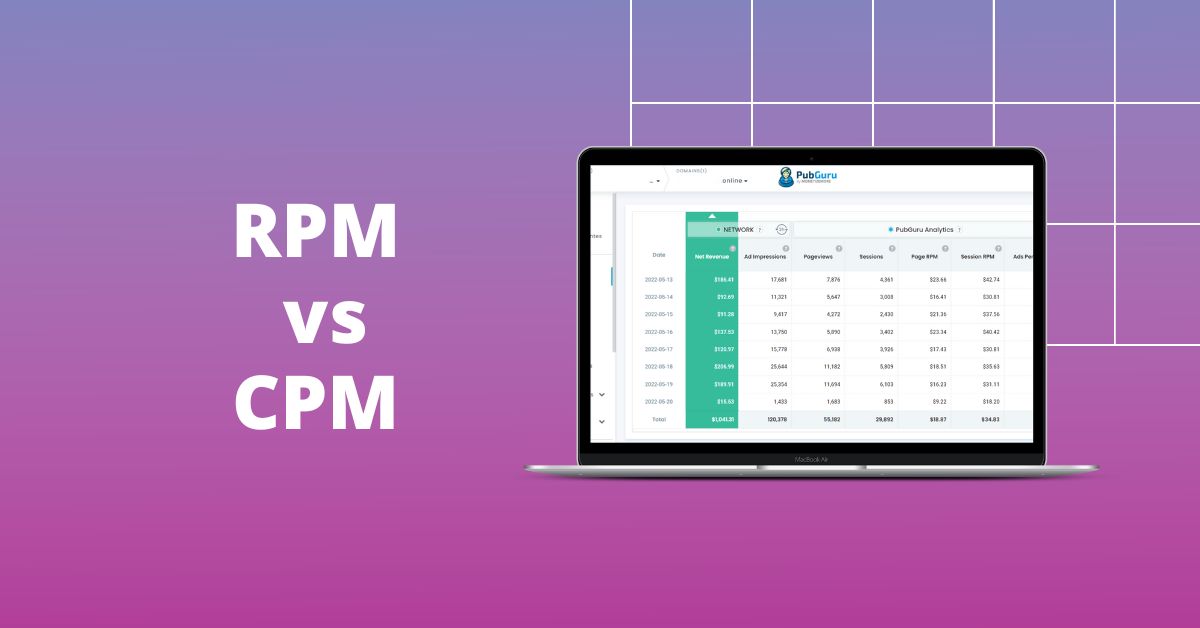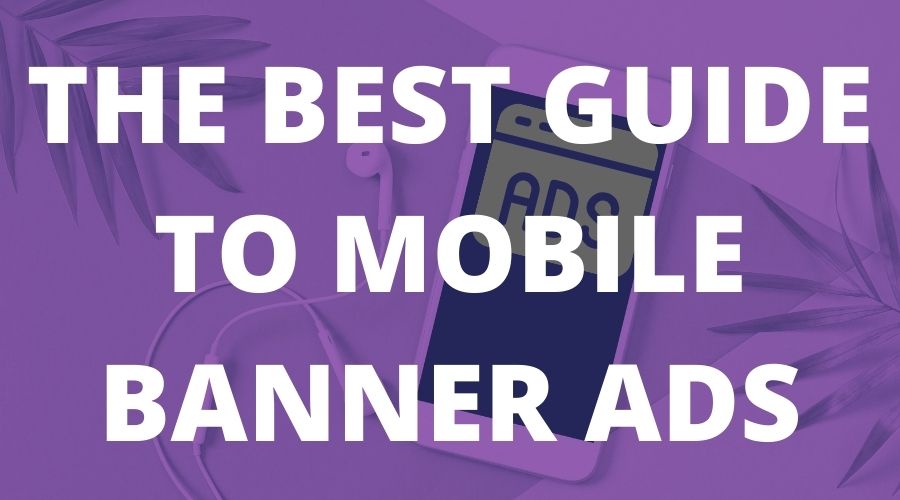
This post was most recently updated on April 17th, 2024
When comparing RPM and CPM, there are a few clear distinctions to make. RPM is a metric used to determine the total ad revenue a publisher is set to earn for 1000 ad impressions. CPM, on the other hand, is the amount an advertiser will pay for 1000 ad impressions. While related, the two are not directly interchangeable in programmatic advertising.
By the end of the guide, you’ll be able to speak confidently about these metrics and impress your team! Let’s jump in…
RPM (Revenue Per Mille) is an estimated measure of the revenue a publisher earns for every 1000 pageviews. It considers all ad impressions on a page along with factors like fill rates and ad formats.
It’s considered a publisher metric because, unlike CPM, RPM takes into account a site’s page views and doesn’t rely on ad impressions alone. RPM also takes into account all of the ads on your site’s pages.
It can be mistaken as a payment figure, but in reality, it’s more of an estimation of what the publisher could earn from ad revenue. Since it’s an estimation, it may not always be how much a publisher will get paid for their ad impressions.
RPM = (Estimated earnings / Number of page views) * 1000
Here’s a simple example to explain RPM further: Let’s say your estimated earnings are $10,000 from 10,000,000 impressions; then you can calculate your RPM as:
($10,000 / 10,000,000)*1000 = $1.00 RPM
On the other end, if your estimated earnings were $7,650 for 6,000,000 impressions, the RPM for that page would be:
($7,650/6,000,000)*1000 = $1.275 RPM
Related Read: https://www.monetizemore.com/blog/what-is-rpm-session-page-ad/
By optimizing your RPM, you can significantly boost your overall ad income. Here’s how:
CPM (Cost Per Mille) is the cost an advertiser pays for every 1000 ad impressions. It’s primarily an advertiser-side metric used to track campaign expenses.
Most people across the industry are familiar with this term, and it’s misused rampantly on the publishing side as it’s an advertiser-side metric to track. CPM ads differ from CPC ads. Every time a CPM ad gets served on a publisher’s website, the publisher earns ad revenue from it. With CPC ads, every time an ad is served on the publisher’s website and a user clicks on it; the publisher earns ad revenue. To calculate the CPM, use the following formula:
CPM = (Cost of the campaign/ Number of total impressions) * 1000
Here’s a simple example to further explain CPM: Suppose the advertiser has a $10,000 ad budget. They launched a CPM ad campaign and received 10,000,000 impressions for their ad campaign.
What’s the advertiser CPM then?
CPM = ($10,000/10,000,000)*1000 = $1.00
For more information on CPM, read our blog post about CPM vs. ECPM here: https://www.monetizemore.com/blog/cpm-vs-ecpm/
It’s easy to get RPM and CPM muddled, even for those in the industry! Let’s clear up some of the most common misunderstandings:
Myth #1: RPM and CPM are interchangeable.
Fact: While related, they measure different things. RPM estimates your earnings potential for every 1000 impressions. CPM is the cost an advertiser pays for those 1000 impressions.
Myth #2: RPM is your guaranteed payout.
Fact: Think of RPM as your earnings forecast. Factors like how many of your ad spots actually get filled (fill rate) and fluctuating advertiser demand can make your final payout differ.
Myth #3: CPM is the only number that matters.
Fact: Advertisers fixate on CPM, but publishers should focus on RPM. It’s your bottom-line indicator of how much you earn per 1000 impressions.
Myth #4: High CPM = High Revenue (Always)
Fact: A high CPM is great, but if only half your ad spots get filled, your overall earnings suffer. Optimizing RPM requires a balance between CPM and fill rate.
Myth #5: RPM and CPM tell the whole story.
Fact: They’re vital, but not the only factors. Track metrics like click-through rate (CTR), how viewable your ads are, and overall user engagement to get the full picture of how to maximize your ad revenue.
We’ve explained below how CPM compares to other key ad metrics, and why understanding the relationships between them is crucial:
CPM measures the cost per 1000 ad impressions, while CPC measures the cost per ad click. CPM campaigns are often used for brand awareness and reach, while CPC campaigns prioritize direct user actions. With CPM, you earn revenue even if users don’t click. With CPC, revenue is tied to clicks, so your site’s CTR (click-through rate) is crucial.
CPM looks at impressions, while CPA focuses on conversions (purchases, sign-ups, etc.). CPM is upstream in the marketing funnel, aiding awareness while CPA is focused on bottom-line results for advertisers. CPA campaigns usually require more user engagement, making website design and calls to action critical to your success.
CPM is a key factor influencing your RPM. Other factors include fill rate (percentage of ads requests filled) and the types of ads you serve. Focus on optimizing both CPM (through better targeting, and placements) alongside those other factors to maximize your RPM.
CPM looks at impressions, while viewability measures if ads were actually seen by users (not just loaded on a page). While CPM is important for revenue, advertisers are increasingly focused on viewability to ensure their ads have an impact.
Optimize page design and ad placements to combat issues like ads loading below the fold that hurt your viewability and, consequently, your ability to attract premium advertisers.
RPM |
CPM |
|
also known as Revenue Per Mile |
also known as Cost Per Mile |
| RPM’s various modes: 1. Impression RPM 2. Ad RPM 3. Page RPM 4. Ad-Request RPM | CPM’s two modes: 1. CPM 2. eCPM eCPM=CPC*CTR*1000) (eCPM metrics basically evaluates your AdSense paycheck) |
|
Google AdSense enlightened RPMs |
CPM is well-known because of header bidding |
|
Calculates publisher’s total ad revenue |
Calculates advertiser’s cost price |
Picture your RPM as a roller coaster – sometimes you’re soaring, and sometimes dips are inevitable. Here’s what controls those climbs and drops:
RPM, CPM, and fill rate are all important metrics that publishers use to evaluate their ad performance and revenue. RPM (revenue per thousand impressions) and CPM (cost per thousand impressions) are measures of how much revenue a publisher generates for every thousand ad impressions served. Fill rate, on the other hand, measures the percentage of ad requests that are filled with ads.
The relationship between RPM, CPM, and fill rate is complex and interdependent. In general, higher CPMs and fill rates can lead to higher RPMs, but there are many factors that can affect this relationship. For example, a publisher with a high fill rate but low CPMs may have a lower RPM than a publisher with a lower fill rate but higher CPMs.
It’s important to note that the fill rate alone does not determine RPM or CPM. A low fill rate can lead to lost revenue opportunities, but it’s possible to still have a high RPM or CPM if the ads that are served are highly targeted and valuable to advertisers. Publishers need to optimize all three metrics to maximize their ad revenue. This may involve adjusting ad formats, targeting specific audiences, and experimenting with different ad networks and platforms to find the best combination of RPM, CPM, and fill rate.
While RPM and CPM remain crucial metrics, their significance and how they’re calculated is likely to shift. Here’s why:
As a publisher, your primary goal is likely to generate revenue and maximize profitability. While CPM can be an important metric for advertisers to track, focusing solely on this metric can sometimes lead to suboptimal revenue generation for publishers. Instead, we recommend that you focus on the RPM metric, which considers both ad impressions and revenue earned.
By focusing on RPM, publishers can better understand how their ad inventory is performing and make informed decisions about pricing and inventory management. Additionally, by maximizing RPM, publishers can increase their overall revenue and profitability, ultimately the end goal of any advertising strategy.
While CPM is certainly an important metric, it only tells part of the story. By focusing on RPM, publishers can get a complete picture of their ad performance and make better decisions about their advertising strategy. So, if you’re looking to maximize revenue and profitability, we recommend that you shift your focus to the RPM metric and start reaping the benefits today.
All set to supercharge your ad revenue by over 50%?
Sign up to MonetizeMore and let’s get that ad revenue paycheck rollin’.
The specific rate per CPM cannot be averaged in a straightforward manner. Instead, rates for CPM are arrived at by considering various factors such as time, platforms used, and the location targeted. These elements play a significant role in determining the rates, making it impractical to arrive at a singular average rate for CPM.
CPM is considered the best pricing model for larger publishers because it enables advertisers to pay a fixed price that is determined by the number of impressions generated by an ad placement. This approach provides a straightforward and predictable pricing structure for publishers, allowing them to efficiently manage their ad revenue. CPM pricing aligns well with the scale of larger publishers who typically have high traffic volumes, making it a favorable choice due to its ability to accommodate a large number of ad impressions.
CPM indicates the cost of one thousand ad impressions on a page or site. Besides the 'M' representing 'thousand,' CPM indicates the cost of one thousand ad impressions on a page or site.
CPM = (Cost of the campaign/ Number of total impressions) * 1000.

With over ten years at the forefront of programmatic advertising, Aleesha Jacob is a renowned Ad-Tech expert, blending innovative strategies with cutting-edge technology. Her insights have reshaped programmatic advertising, leading to groundbreaking campaigns and 10X ROI increases for publishers and global brands. She believes in setting new standards in dynamic ad targeting and optimization.



10X your ad revenue with our award-winning solutions.